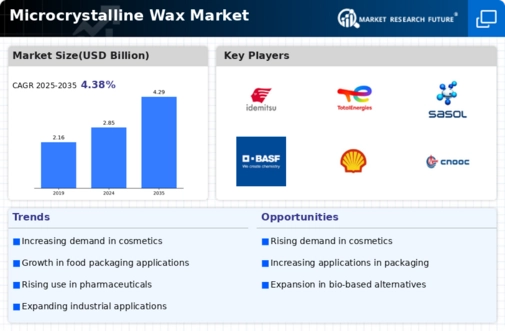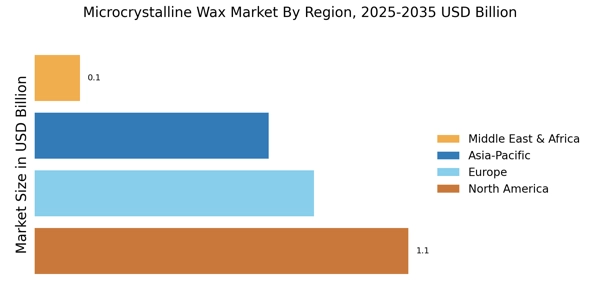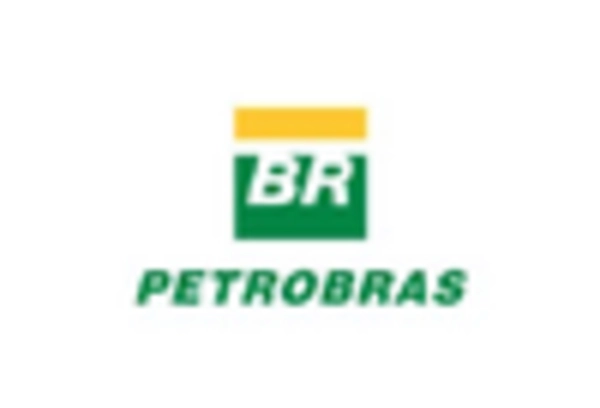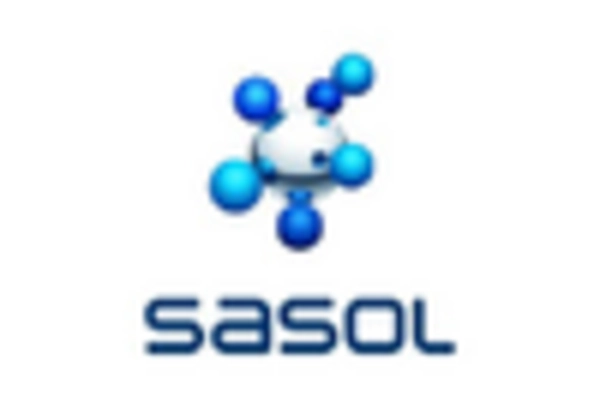Expanding Use in Pharmaceuticals
The Microcrystalline Wax Market is witnessing an expansion in its use within the pharmaceutical sector. This wax serves as an excipient in drug formulations, providing stability and controlled release properties. The pharmaceutical industry is anticipated to grow at a rate of approximately 6% annually, driven by increasing healthcare demands and advancements in drug development. As the need for effective drug delivery systems rises, microcrystalline wax is likely to play a crucial role in enhancing the efficacy of various medications. This growing application in pharmaceuticals presents a significant opportunity for manufacturers of microcrystalline wax to cater to this expanding market.
Innovations in Packaging Solutions
The Microcrystalline Wax Market is poised for growth due to innovations in packaging solutions. Microcrystalline wax is increasingly used in the production of flexible packaging materials, which are essential for preserving product integrity and extending shelf life. The packaging industry is evolving, with a focus on sustainability and efficiency, leading to a projected growth rate of 3.5% in the coming years. As manufacturers seek to enhance the performance of their packaging, the incorporation of microcrystalline wax can provide improved barrier properties and moisture resistance. This trend indicates a promising future for microcrystalline wax as a key ingredient in advanced packaging solutions.
Growth in Food and Beverage Applications
The Microcrystalline Wax Market is significantly influenced by its applications in the food and beverage sector. This wax is utilized as a coating agent for various food products, enhancing their appearance and shelf life. It is particularly effective in preventing moisture loss and maintaining freshness, which is crucial in a competitive market. The food industry is expected to expand, with a projected growth rate of around 4% annually, thereby increasing the demand for microcrystalline wax. Additionally, as food safety regulations become more stringent, the use of microcrystalline wax as a food-grade coating may gain traction, further solidifying its position in the market.
Increased Focus on Eco-Friendly Products
The Microcrystalline Wax Market is influenced by the rising consumer preference for eco-friendly products. As sustainability becomes a priority for many industries, manufacturers are exploring the use of bio-based alternatives and sustainable sourcing for microcrystalline wax. This shift is likely to attract environmentally conscious consumers, potentially increasing market share. The trend towards eco-friendly formulations is expected to grow, with a projected increase of 5% in demand for sustainable ingredients across various sectors. Consequently, microcrystalline wax producers may need to adapt their sourcing and production methods to align with these evolving consumer preferences, ensuring their relevance in a competitive market.
Rising Demand in Cosmetics and Personal Care
The Microcrystalline Wax Market experiences a notable surge in demand driven by the cosmetics and personal care sector. This wax is favored for its ability to enhance texture and stability in various formulations, including lipsticks, creams, and lotions. As consumers increasingly seek high-quality, long-lasting products, manufacturers are incorporating microcrystalline wax to meet these expectations. The market for cosmetics is projected to grow at a compound annual growth rate of approximately 5% over the next few years, indicating a robust opportunity for microcrystalline wax suppliers. Furthermore, the trend towards natural and organic products may also bolster the demand for microcrystalline wax, as it is derived from petroleum and can be marketed as a versatile ingredient in formulations.


















Leave a Comment